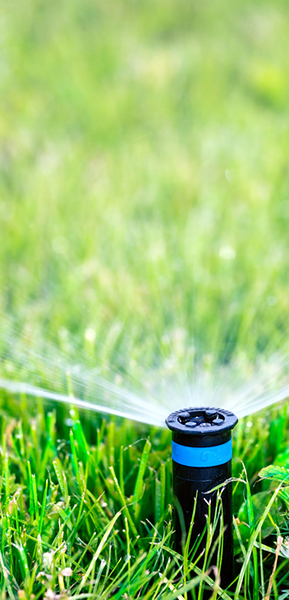LAWN CARE TIPS
A healthy lawn contributes to your property value and the overall appearance of your neighbourhood. It provides a natural, safe surface where your family can play and relax. By following a few simple tips, you can keep your lawn healthy and environmentally beneficial.
- Water frequently and deeply to encourage deep roots. It’s difficult to say how much water to apply since it depends on soil type, species of grass, mowing height, temperature, wind and other factors.
Measure rainfall and sprinkler water with a rain gauge or a container with straight vertical sides, such as a coffee can or other type of tin can.
- Generally, one inch is considered an adequate soaking. High spots and south-facing slopes will need more water than other areas.
- Apply less water in shady areas that receive less than 4 hours of direct sunlight daily. Grass under large trees will need more water since the tree roots will consume water and the trees canopy may intercept rainfall.
- Early morning watering is ideal. Less water is lost through evaporation and wind. Watering in the evening leaves the lawn wetter longer and increases the likelihood of disease problems.
- Your lawn may become brown during hot, dry spells. It’s in a dormant state and will green up again when wetter and cooler weather returns. A healthy lawn can survive several weeks in a dormant state.
- Ideally, a home lawn only needs to be fertilized when nutrient levels drop below what’s needed to maintain it in a healthy condition.
- Compost will add organic matter and provide the major and minor nutrients in a slow release form.
- Organic fertilizers such as an activated sewage sludge or steer manure may also supply all the nutrients needed for healthy growth.
Inorganic commercial fertilizers usually contain the three major nutrients:
– Nitrogen (N) to promote leaf growth and dark green colour
– Phosporous (P) for root growth
– Potassium (K) for stress resistance
The three numbers on the bag represent the percentages of each of these elements (always in the order “N-P-K”). Unless the instructions say otherwise, inorganic, commercial fertilizers must always be watered-in after they have been applied. Otherwise, you will burn your lawn.
The type of grass, type of soil, age of the lawn, weather conditions and other factors mentioned above, such as returning clippings and watering frequency, will all determine rates and timing of fertilizing applications. A soil test by a professional laboratory is the only sure way to access nutrient needs accurately.
- Lawn grasses need at least four hours of direct sunlight for healthy growth.
- If the lawn receives much traffic, it should get six hours of direct sun daily.
- Select the right species of grass to ensure you’ll have a healthy lawn in shady areas.
- Creeping red fescue tolerates shade better than Kentucky bluegrass.
- Do not mow any shorter than three inches in the shady areas of your lawn.
- Fertilize and water shady areas less than the sunny part of your lawn.
- If you’re having difficulty maintaining grass cover in areas where people walk, put in a stone or a bark chip path to keep traffic off the grass.
- Often shade-tolerant ground covers are an excellent alternative to grass in shady areas that don’t need to carry traffic.
(Factsheet prepared by Alberta Agriculture and Rural Development)

LAWN REPAIRS
A healthy lawn contributes to your property value and the overall appearance of your neighbourhood. It provides a natural, safe surface where your family can play and relax. By following a few simple tips, you can keep your lawn healthy and environmentally beneficial.
If you have just a few broadleaved weeds scattered throughout your lawn, consider having them removed manually before they produce seed heads. If you choose to use herbicides, spot spray the weeds rather than treating the whole lawn. Avoid using weed bars or weed n’ feed products. Always read product labels and wear protective clothing when using herbicides.
Turf diseases are easily confused with other problems such as dog urine, fertilizer burn, dull mower blades, road/side-walk salt, or compacted soil. Fungicide applications are almost never warranted on home lawns in Manitoba. A lawn consisting of a blend of various Kentucky bluegrass cultivars mixed with some creed red fescue will resist diseases well. If a disease occurs, some plants in this mixture may be susceptible, but most others will be resistant.
Fairy ring is the home lawn disease that most frequently causes concern. It causes a circular or semi-circular ring, varying from a few inches to 50 feet or more in diameter, of dark green grass, which may die over time. Mushrooms often follow the ring pattern, particularly in spring and fall. If it’s not severe, you can mask the problem with an application of nitrogen fertilizer. Spiking the area just outside the dead ring with a garden fork then soaking it with soapy water and keeping it soaked with hose water may help lessen the problem. A more drastic solution is to remove the soil 18-24 inches in front and behind the dead ring to a depth of 12-36 inches (depending on the development of the fungus).
You can repair larger dead patches by reseeding. Mix grass seed into compost or soil in a container such as a bucket, then spread the mixture over the dead spot. Lightly pack it by stepping on it but make sure it’s dry before you do so (you’ll pack it too much if it’s wet). Then keep the area watered until the seedlings become established.
If the bare patch is in a high traffic area, you may prefer to replace the dead grass with new sod. Cut out the dead sod to about an inch deep, rake the soil, place the new sod and firm it by stepping on it or rolling it. Then keep it well watered until the new sod is established.
